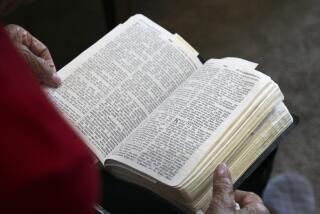You Can Say That Again : An examination of the English language : EMPIRE OF WORDS: The Reign of the OED, <i> By John Willinsky (Princeton University Press: $22.95; 258 pp.)</i>
- Share via
Most “wordsmiths”--and this reviewer is smug enough to consider himself at least a “word nut”--hasten to examine and often buy every study of the language, from a new volume by William Safire to a new edition of the “U.S. News & World Report Stylebook.” And a good many such enthusiasts hasten into print as critics of such books when they get the opportunity.
Here is one of the ultimate such examinations: John Willinsky, a professor at the University of British Columbia, offers a study of the Oxford English Dictionary and how it got that way, its often subtle omissions and prejudices, and the absolute vastness of its achievement.
The first paragraph of Chapter 1 took this reviewer by surprise by stumping him to his chagrin with a word he had never heard before: “the fascicles of a new dictionary.” But Webster’s New World defines a fascicle as “any of the sections of a book being brought out in installments prior to its publication in completed form.” A lesson learned in the first paragraph!
What concerns Willinsky is the “selection of citations,” that is, the choice of examples the OED supplies to illustrate the definitions. “Who and what the citations represent” is the question, and they constitute “the construction of a usable past, a selective tradition that is by all means made up of the literary tradition of Shakespeare and the Bible, but is filled out with broad representation from the British boot trade and working press running from Grub Street and Drury Lane to Fleet Street.”
Willinsky gives us some dates, some historical figures: Richard Trench, later archbishop of Dublin, who is credited with the initial suggestion in 1857; Hubert Coleridge, grandson of the poet, and James Murray, who did his lexicographic work in a shed that one visitor said was “like a tool house, a washhouse or a stable.” It was Murray who wrote, “Quotations will tell the full measure of meaning, if you have enough of them.” And it was Murray’s 10th and youngest child who recalled that “the starting rate was one penny an hour” for helping in the search for citations.
There is an entire chapter on the OED’s citations from Shakespeare’s “The Taming of the Shrew,” and it is almost enough to make you go back and read the play. Among the subjects here are the difference between basins and ewers, the different meanings of smack, the changes in diaper and the meaning of trousers , as in “wearing trousers over his breeches .”
Dickens was the “sole novelist” cited in the first 1928 edition, and there were remarkably few women.
A four-volume Supplement appeared from 1957 to 1986 and was presided over by Robert Burchfield, a New Zealander. This Supplement reached out to “the special vocabulary of the West Indies and, nearer home, Scotland.” It also saw the influence of critic Marghanita Laski, who traced alleycat to Don Marquis’ “archy and mehitabel” and reported such usages as fab and goody goody gumdrop.
Vulgarities such as the “f-word” and the “c-word” made their appearance. And a new sensitivity to the use of ethnic terms is demonstrated in the citations for the word Jew when used either as a noun or a verb. Burchfield also insisted, “ ‘Offensiveness’ to a particular group or a faction is unacceptable as a ground for the exclusion of any word or class of words.”
A few more touches of the Supplement: Eliot and Kipling; the Baltimore Sun as the Supplement’s leading American newspaper source of citations; the introduction of 50,000 new words. The Supplement, Willinsky says, “comes to reflect a decentering of the language, a separation of English from England.” It demonstrates “an English that has found a life abroad. . . .”
The Second Edition of the OED (1984-89) bears the imprint of the computer: “The record of the English language is now suspended in an electromagnetic field, its body malleable and plastic.” Among its citations are Joyce’s “Ulysses,” John Denver’s “Annie’s Song,” Joseph Heller, Joseph Wambaugh and Gore Vidal.
Willinsky winds up by pointing out those whose citations are relatively few. He cites the clerks of England’s 15th-Century Chancery courts and the poets of the 19th-Century Romantic Revival. One wonders why there is no mention of the presence or absence of Canadian citations: Stephen Leacock? Bliss Carman? Mazo de la Roche? Morley Callaghan?
He refers to “the expressly masculine citational authority” but he does mention citations from Mary Wortley Montague, George Eliot, Harriet Beecher Stowe, the Bronte sisters and, more recently, Ngaio Marsh, Agatha Christie and Lady Bird Johnson.
To sum up:
“The OED is far more a record than a rule book.” Willinsky has made a significant contribution to the appreciation and enjoyment of our language. His examination of “the act of citation” is fascinating. To be sure, the book can become ponderous but it is, after all, dealing with weighty volumes. If you’re a word nut, you need it. Even if you’re only casually interested in our language, there are scores of tidbits that will intrigue.
More to Read
Sign up for our Book Club newsletter
Get the latest news, events and more from the Los Angeles Times Book Club, and help us get L.A. reading and talking.
You may occasionally receive promotional content from the Los Angeles Times.







